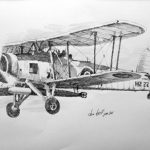Reconnaissance Car (Marmon Herrington)

Restored by Eric Tyler
The South African Reconnaissance Car, also known as the Marmon-Herrington Armoured Car, was produced in South Africa during the Second World War.
Initiated in 1938 by the South African Government, the first version was based on a Ford 3 ton chassis, imported from Canada, and fitted with a four wheel drive conversion kit from the American company Marmon-Herrington. The armour was produced by the South African Iron and Steel Industrial Corporation. Final Assembly was carried out by the Dorman Long Company.
The MkI, of which model 135 units were built, entered service in 1940. This was a 2 wheel drive model, armed with two Vickers guns. This saw brief action against the Italians in the Western Desert, but was rapidly consigned to training duties.
The MkII and MkIII were 4×4 models, and were used extensively during the North African campaign, mainly in a reconnaissance role. The normal armament was a co-axial Bren Gun, and one or two Anti-Aircraft machine guns, and a Boyes Anti-Tank rifle mounted in the turret.
Many armament modifications were carried out in the field, and among the variations was the installation of the 20mm and 47mm Breda, the German 37mm Pak, the French 25mm, the 20mm Oerlikon cannon and the British 2 pounder Anti-Tank gun.

A MKIV in Bloemfontein.
In 1943 a completely redesigned MkIV entered the fray. This had a 2 pounder gun as standard armament, with a .30 Browning machine gun mounted next to the 2 pounder. Another .30 Browning was normally fitted to turret as an Anti-Aircraft weapon.
A number of other models were built. In 1943 a MkIVF was introduced due to the difficulty of obtaining the Marmon-Herrington conversion kit. This unit was based on the Canadian F60L four wheel drive 3 ton truck chassis. Interestingly, the vehicle was still referred to as the Marmon-Herrington.
In 1942 the Mk V, an 8 wheel prototype based on a German design, was built. This single unit was followed by the MkVI, of which two units were built. MK VII and MKVIII were similar, but had different armament.
The units were used by many armed forces, and saw service in the Greek Army until the 1990’s.



































